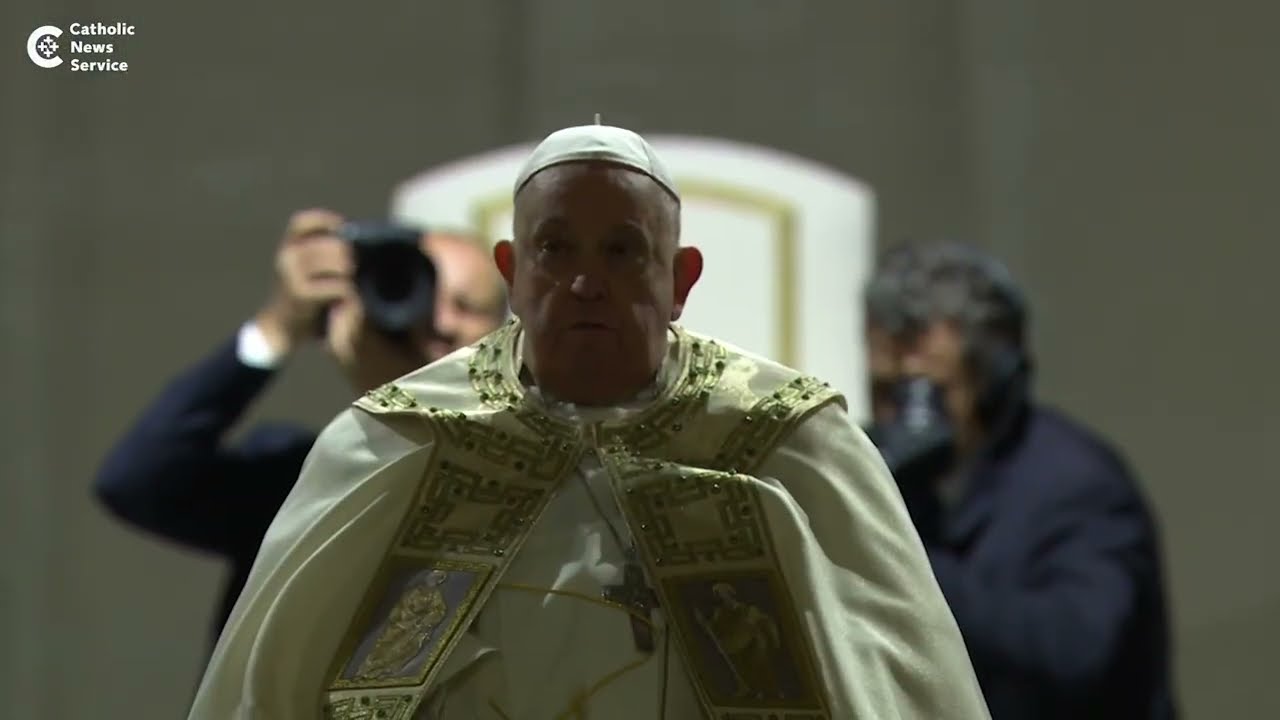Pope opens Holy Door of St. Peter’s Basilica, launching ‘Jubilee of Hope’
VATICAN CITY (CNS) — In the quiet of Christmas Eve, Pope Francis opened the Holy Door of St. Peter’s Basilica, launching what he called a “Jubilee of Hope.”
As the doors opened, the bells of the basilica began to peal.
After the reading of a brief passage from the Gospel of John in which Jesus describes himself as “the door,” Pope Francis briefly left the atrium of the basilica, creating some confusion. But when the cardinals in the front row sat down, the others did likewise.
Three minutes later, the pope returned. He was pushed in his wheelchair up the ramp to the Holy Door. In silence, he raised himself from the chair to knock five times, and aides inside slowly opened the door, which had been framed in a garland of green pine branches, decorated with red roses and gold pinecones.
Opening the Holy Door of St. Peter’s Basilica has been a fixture of the Catholic Church’s celebration of jubilee years since the Holy Year 1450, the Vatican said.
Pope Francis chose “Pilgrims of Hope” as the theme for the Holy Year 2025, which began Dec. 24 and will run through Jan. 6, 2026.
The rite of opening the decorated bronze door began inside the basilica with the reading in different languages of biblical passages prophesying the birth of the savior “who brings his kingdom of peace into our world,” as the lector explained.
Then, to emphasize how the birth of Jesus “proclaims the dawn of hope in our world,” the Gospel of St. Matthew’s account of the birth of Jesus was proclaimed.
Introduced with a blare of trumpets, the choir sang, “Let us go rejoicing to the house of the Lord.”
“The steps we now take are the steps of the whole church, a pilgrim in the world and a witness of peace,” the pope told the assembled cardinals, bishops, ecumenical guests and lay faithful in the atrium of the basilica.
“Holding fast to Christ, the rock of our salvation, enlightened by his word and renewed by his grace,” the pope continued, “may we cross the threshold of this holy temple and so enter into a season of mercy and forgiveness in which every man and woman may encounter and embrace the path of hope, which does not disappoint.”
Echoing the biblical jubilee themes of reconciliation and forgiveness, Pope Francis prayed that the Holy Spirit would soften hardened hearts so that “enemies may speak to each other again, adversaries may join hands and people seek to meet together.”
“Grant that the church may bear faithful witness to your love and may shine forth as a vital sign of the blessed hope of your kingdom,” he prayed.
Normally the Holy Door, to the right of the basilica’s center doors, remains sealed with bricks, a symbolic reminder of the barrier of sin between people and God. The 16 panels on the bronze doors illustrate key moments in salvation history, including the fall of Adam and Eve, the annunciation of Jesus’ birth, Christ presented as the shepherd rescuing a lost sheep, the crucifixion and the risen Jesus appearing to the disciples.
Ten children from 10 different countries, holding hands with their parents, crossed the threshold after the pope and the altar servers, but before the cardinals and bishops. Then 54 people from 27 nations — including the United States and Canada, Australia, Tanzania and Togo, Venezuela and Vietnam — passed through. Many of them wore the traditional dress of their nations or ethnic groups.
Neither the Vatican press office nor the Jubilee press office released the names of the pilgrims or explained how they were chosen.
Also among the first to cross the threshold were representatives of other Christian churches. The Dicastery for Promoting Christian Unity said in an explanatory note, “Entering through the Holy Door expresses the willingness to follow and be guided by the only begotten Son of God.”
Especially during the year that will see the celebration of the 1,700th anniversary of the Council of Nicaea, which solemnly defined the basics of Christian faith, the ritual “is a manifestation of the faith that all Christians share in Jesus, the Eternal Word made man,” the note said.
However, it added, the ecumenical guests’ participation “must not be interpreted as an attempt to associate them with elements of the jubilee, such as the jubilee indulgence, which are not in line with the practices of their respective communities.”
In fact, the “selling” of indulgences helped spark the Protestant Reformation; the practice was later banned by the Council of Trent.
The Catholic Church believes that Christ and the saints have accumulated a treasure of merits, which other believers — who are prayerful and repentant — can draw upon to reduce or erase the punishment they are due because of sins they have committed. Making a pilgrimage, going to confession, receiving Communion and offering prayers to receive an indulgence is a key part of the Holy Year.
